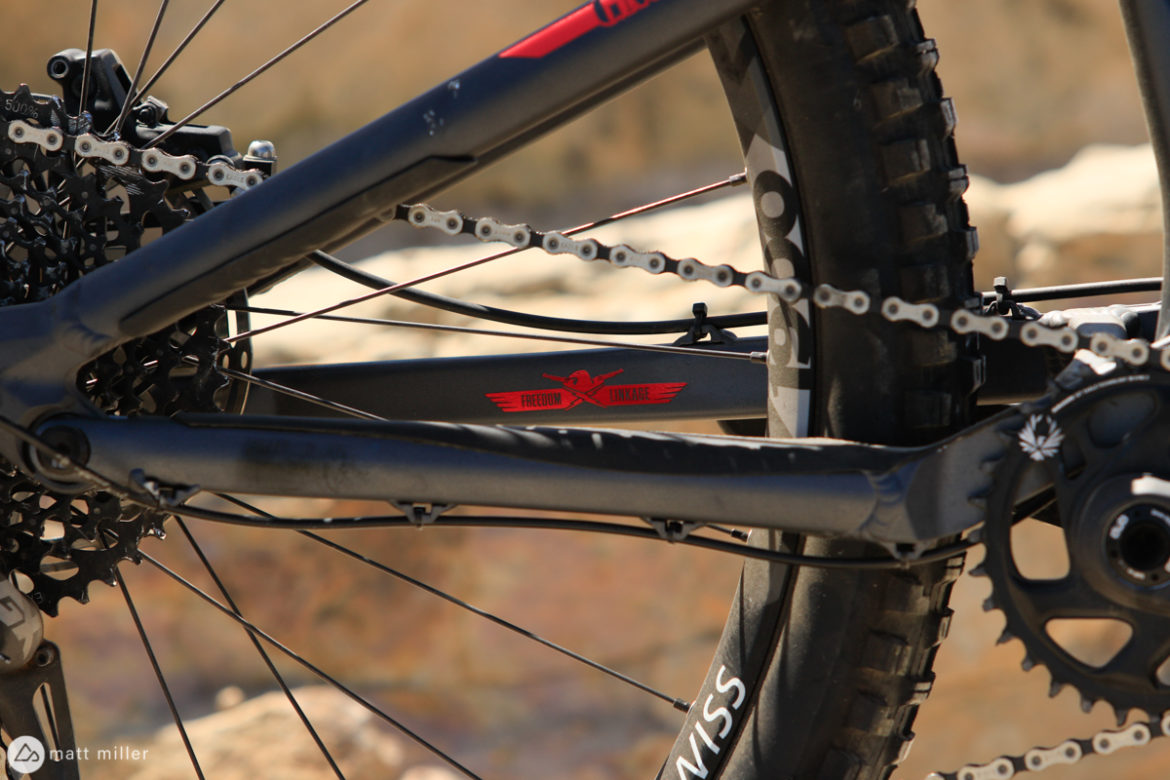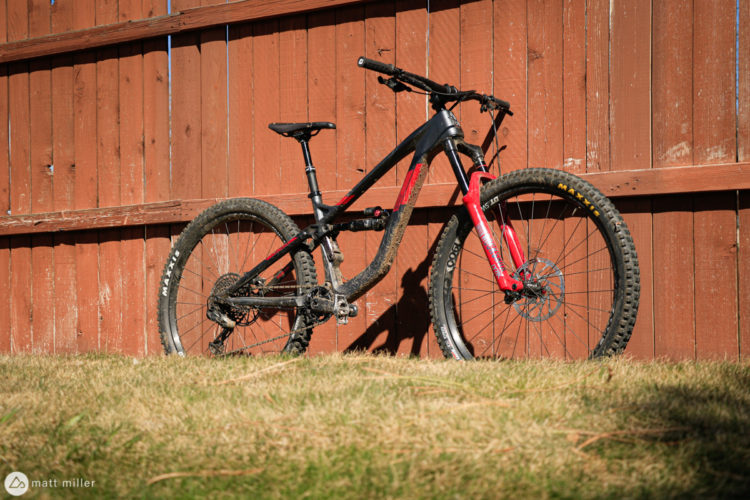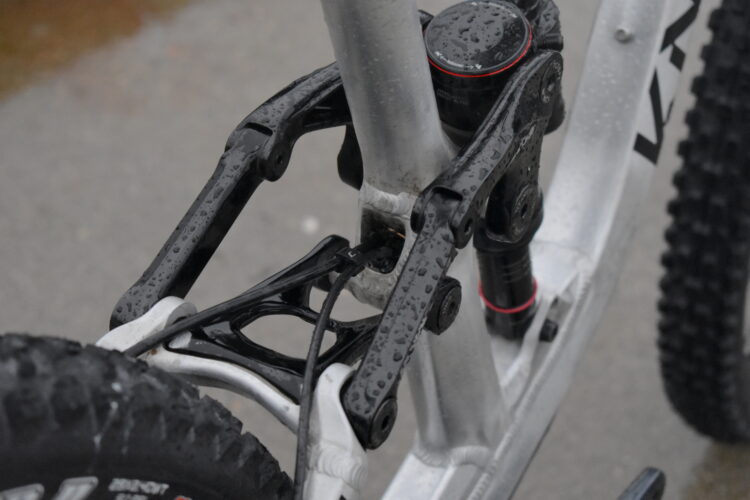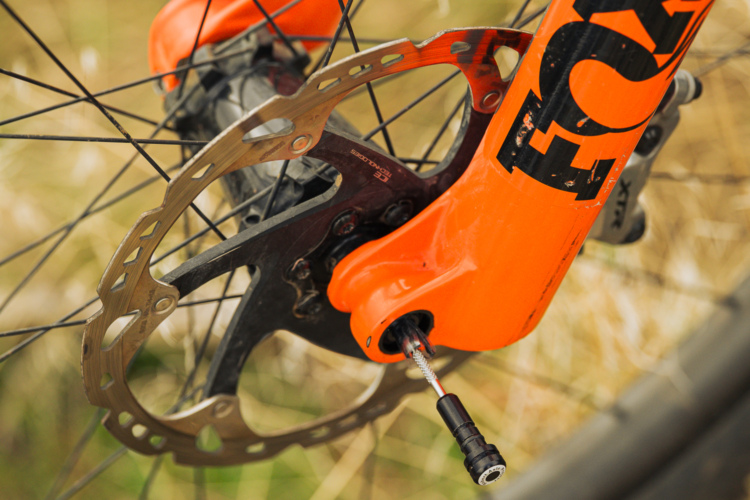
Guerrilla Gravity started with big bikes. The first two in their available stable, the GG/DH and the Megatrail were a downhill and an enduro bike, respectively, and those are the types of bikes most would expect from a brand with “gravity” in the name. Over time, they added smaller travel options, and even a hardtail, but all of them were crafted with progressive geometry and a focus on descending.
Over the years, fans have noticed an opening in Guerrilla Gravity’s lineup. There was an empty spot at the tall end of the stable for a long-travel 29er. Fans speculated that it might have been called the MegaSmash, but that became the moniker for the Megatrail and The Smash mixed-wheel hybrid. Others suggested something like the “Warpig.” The Gnarvana rounds out the top spot nicely though, and today, Guerrilla Gravity has an actual long-travel 29er in its book.
Details

So what sets the Gnarvana apart from The Smash? The rear travel was increased by 15mm to 160mm, and there is a 20mm longer fork, for a total of 160/170mm R/F travel. The chainstay length was stretched to 450mm to create a very stable ride, and the geometry as a whole is much different.
In its long headset orientation, the Gnarvana has a 63.7° HTA, and a 76.1° STA. The wheelbase is very long also, and hits 1,239mm in the size 2 I rode, 23mm longer than The Smash. Standover height is 5mm taller, and the reach is actually 11mm shorter on the Gnarvana. In the long orientation, it measures 445mm.
Only three sizes — 2, 3, and 4 — are available for the Gnarvana, just like the Smash.

The three build kits that Guerrilla Gravity typically specs for their models are available on the Gnarvana. For $3,895, a Gnarvana comes with a RockShox Lyrik Select fork, and Deluxe Select+ rear shock. Then, a SRAM NX Eagle drivetrain, and Code R brakes make up the groupset.
On the Rally build, the Gnarvana comes with a Lyrik Ultimate fork, and Fox DPX2 rear shock, with a SRAM GX drivetrain, and Code RSC brakes, rounded off with Stan’s MKIII wheels, for $4,795.
The top-of-the-line Race build comes with a Fox 38 Grip 2 fork and X2 rear shock, along with a SRAM XO1 Eagle drivetrain, Industry Nine Grade 300 wheels, and SRAM Code RSC brakes for $6,395.
Currently, seatstay kits ($445) have a 2-week lead time for those interested in changing one of their GGs to a Gnarvana. Framesets have a 2-4 week lead time, and are priced at $2,195, while completes will have a 3-4 week lead time, starting with the Ride build at $3,895.

Guerilla Gravity bikes can be ordered direct-to-consumer style, or they can be ordered through a local bike shop in the US and Canada. They are also available through international distributors in Chile, Israel, Malaysia, Mexico, and Singapore.
Ride impressions

I was able to get a few rides on the Gnarvana in the midst of the current level of craziness. This is obviously a bike that is meant for serious speed, air, and impacts. To be mindful of how we should be riding right now, I gave it a little bit of each ingredient, but kept the rev-meter at about 60%, well within my limits.
A week before riding the Gnarvana I had been riding The Smash, the 145mm 29er by GG. It made for a timely round of back-to-back testing, and when I wrapped up my rides on The Smash, I took the bike back down to the “Shredquarters,” and the folks at Guerrilla Gravity swapped the seat stay, the rear shock, and the fork on The Smash to convert it to a Gnarvana. Simple as that, it became a new bike. Although, it can still be a pricey change. The seat stay kit is $445, and a new shock ain’t cheap.

The sag on the Gnarvana is still recommended at around 30-35%. I put in around 185-190psi in the Fox DPX2 shock to get it near 30% sag. The Gnarvana settles into its stroke and there is some noticeable bob climbing in open mode. Pedaling efficiency is less firm than The Smash and on buff, sustained climbs I switched the DPX2 into its middle position to minimize bob.
The single available suspension mode on the Gnarvana is considered “Plush” mode on other Guerrilla Gravity bikes, and it does feel like a bigger version of the suspension kinematics on The Smash. You’ll likely find yourself dipping halfway into the shock stroke on technical climbs. That can give a lot of traction, and feels really nice climbing up loose, technical stuff, which likely means you’re on the road to a good descent and the Gnarvana’s bread and butter. On steep climbs, I felt that I had to inch closer to the nose of the saddle to keep my weight forward.

Overall though, the geometry on the Gnarvana felt roomy, stable, and low. It’s getting very impressive with how brands have been able to fit so much travel into 29-inch wheels, and still allow for a playful and agile feel. This is no different on the Guerrilla Gravity Gnarvana, and pointed down, the handling is responsive at speed, easy to get around tight corners, and it’s still easy to pop the front end up for manuals and jumps.
The suspension has a planted feel on descents, and like I noticed with The Smash in Plush mode, the small bump sensitivity on the Gnarvana felt coil-smooth with the smaller, DPX2 air can. The DPX2 is solid, but I’m sure a lot of buyers wouldn’t mind seeing a larger air can on the Ride and Rally builds. Still though, the rear wheel stuck to the ground, without hovering inside of its middle stroke, and on bigger drops there is an easy ramp up, devoid of any harsh feeling.

The Gnarvana was an easy bike for me to get along with quickly and didn’t require a lot of fussing around with settings. Like other GG bikes, there is still some adjustability in the headset, and it can be changed from a long to a short orientation, reducing the wheelbase, reach, and effective top tube.
Consumers only lose the ability to change suspension modes. I didn’t enjoy Crush mode on The Smash during my time with it, and appreciate the simplicity of one suspension mode that is optimized around all conditions, as is the case on the Gnarvana. There is obviously one thing on the Gnarvana’s mind anyway, and that is big and rough descents.
To draw some comparisons to other bikes which I’ve ridden, and those buyers may also be considering over the Gnarvana, the Pivot Firebird and Rocky Mountain Slayer ride in the same class. Both the Firebird and Slayer had more firm pedaling platforms, and the geometry on both felt more fitting for climbs. But, the Slayer was much heftier to pedal (my test Slayer was 3lbs heavier than the Gnarvana), and the Firebird didn’t feel as playful or easy to throw around as the Gnarvana.
Closing thoughts

There are going to be a lot of riders stoked on the Gnarvana who have been eagerly awaiting a long-travel 29er from Guerrilla Gravity to come In Bloom. It’s a light, and capable climber, and it won’t Drain You on the way to the top. For gravity-only riders, it gets even better and is a great A-Scentless Apprentice for shuttle or bike park riders. After all, that is the primary mission and the Gnarvana is made to get to the bottom of the mountain as fast as possible, taking away All Apologies.
Ride along with Matt as he checks out the Gnarvana on his local trails at White Ranch in Colorado.




















0 Comments